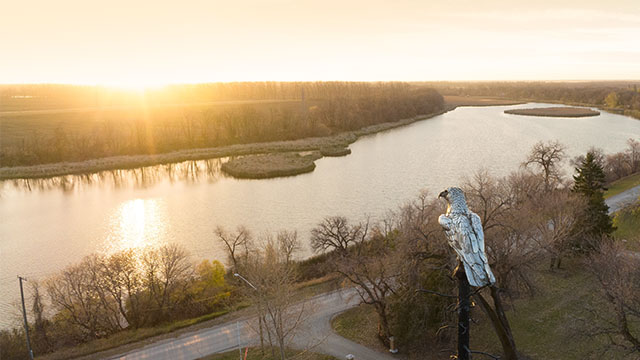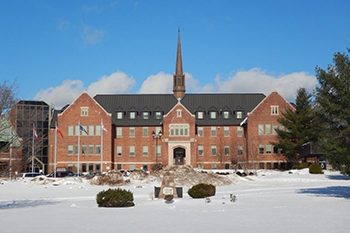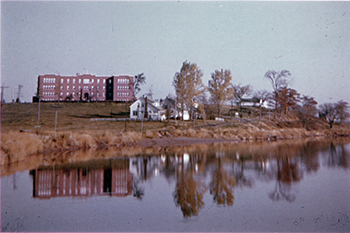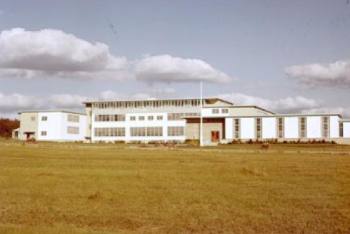
Learn more about the Healing on our lands banner artwork.
Residential schools in Canada
The Residential School System is a topic that may cause trauma invoked by memories of past abuse. The Government of Canada recognizes the need for safety measures to minimize the risk associated with triggering. A National Residential School Crisis Line has been set up to provide support for former residential school students and their families. You can access information on the website or access emotional and crisis referral services by calling the 24-Hour National Crisis Line: 1-866-925-4419.

Remembering residential schools
Truth and Reconciliation: Survivors and descendants share their personal experiences.
On September 1, 2020, the Government of Canada announced the designation of the Residential School System as a national historic event under the National Program of Historical Commemoration.
The Residential School System has impacted multiple generations of Indigenous peoples, with long-term detrimental effects on First Nations, Inuit, and Métis communities, cultures, economies, traditional knowledge and ways of life, languages, family structures, and connections to the land.
The Government of Canada recognizes this as a tragic event in our shared history and, with Indigenous peoples and communities who are ready to do so, is committed to raising awareness of the experiences of the children who attended these schools to ensure that this history is acknowledged and better understood by all Canadians.
Designations related to Residential schools in Canada
The Residential School System National Historic Event
Residential schools for Indigenous children existed in Canada from the 17th century until the late 1990s. During the 19th and 20th centuries, a formal system for the residential schooling of Indigenous children was established and expanded throughout Canada. It is estimated that at least 150,000 First Nations, Inuit, and Métis children attended residential schools during this period. These schools were largely operated by certain churches and religious organizations and administered and funded by the federal government as a key aspect of colonialism. The system was imposed on Indigenous peoples as part of a broad set of assimilation efforts to destroy their rich cultures and identities and to suppress their histories. Throughout this period, Indigenous peoples fought against the system in many ways. The efforts of residential school survivors to tell their stories and to seek justice have been a crucial catalyst in the growing public recognition of the harm and effects of residential schools.
The National Centre for Truth and Reconciliation nominated the Residential School System for consideration under the National Program of Historical Commemoration and its designation as a national historic event reflects the input of Survivors from across the country.
Survivors, Indigenous communities and organizations interested in installing a Historic Sites and Monument Board of Canada bronze plaque to mark the national historic event designation of the Residential School System at a former residential school site should contact Parks Canada at clmhc-hsmbc@pc.gc.ca.
Former Muscowequan Indian Residential School National Historic Site, Saskatchewan

© Parks Canada / Allison Sarkar
Designated as a national historic site in 2021
Located on the reserve lands of Muskowekwan First Nation in Treaty 4 Territory (southeastern Saskatchewan), the Former Muscowequan Indian Residential School is the only standing residential school in Saskatchewan, and one of the few remaining residential school buildings in Canada. The former school building was built in 1930-31 to replace residential school buildings dating to the late-19th century, and remained open until 1997. For over a century, First Nations and Métis children from Treaty 4 Territory, across Saskatchewan, and elsewhere in Canada were sent to this school.
This site was nominated for designation by Muskowekwan First Nation. Parks Canada and the nominator worked collaboratively to identify the historic values of this former residential school, and to develop the report on the history of the school and the experiences of students, which was reviewed by the Historic Sites and Monuments Board of Canada.
Backgrounder: Former Muscowequan Indian Residential School National Historic Site
Former Shingwauk Indian Residential School National Historic Site, Ontario

© Parks Canada / Nathalie Ouellette
Designated as a national historic site in 2021
Located in Sault Ste. Marie, Ontario, on Robinson-Huron territory on the traditional homeland of the Anishinaabe and the Métis, the Shingwauk Indian Residential School was built in 1934-35 to replace the original school building which dated to the late-19th century. From 1935 to its closure in 1970, more than a thousand Indigenous children from Ontario, Quebec, the Prairies, and the Northwest Territories were sent to this school.
This site was nominated for designation by the Shingwauk Residential Schools Centre (SRSC). Parks Canada, the Children of Shingwauk Alumni Association, and the SRSC worked collaboratively to identify the historic values of the site, and to develop the report on the students’ experiences and the history of the school for the Historic Sites and Monuments Board of Canada.
Backgrounder: Former Shingwauk Indian Residential School National Historic Site
Former Portage La Prairie Indian Residential School National Historic Site, Manitoba

© Parks Canada / Allison Sarkar
Designated as a national historic site in 2020
Built in 1914-1915, the former Portage La Prairie Indian Residential School is located on the Keeshkeemaquah Reserve, part of the reserve lands of Long Plain First Nation. Children from many First Nations and other Indigenous communities in Manitoba and elsewhere were sent to this residential school, which remained open until 1975.
This former residential school site was nominated for designation by the site owner, Long Plain First Nation. Parks Canada worked collaboratively with Long Plain First Nation to identify the historic significance of this former residential school and to develop the submission report for the Historic Sites and Monuments Board of Canada.
Backgrounder: Former Portage La Prairie Indian Residential School National Historic Site
Former Shubenacadie Indian Residential School National Historic Site, Nova Scotia

© Sisters of Charity, Halifax, Congregational Archives
Designated as a national historic site in 2020
The former Shubenacadie Indian Residential School was built in 1928-29 in the Sipekni’katik district of Mi’kma’ki, Nova Scotia and was in use from 1930 to 1967. Many Mi’kmaw and Wolastoqkew children from Nova Scotia, Prince Edward Island, New Brunswick, and Quebec were forced to attend this residential school. It is also possible that children from other Indigenous communities were sent to this school.
The former Shubenacadie Indian Residential School was nominated by the co-chair of the Tripartite Culture and Heritage Working Committee of the Mi’kmaq-Nova Scotia-Canada Tripartite Forum on behalf of Survivors of the Shubenacadie Indian Residential School and their descendants. Parks Canada and the nominator worked collaboratively to identify the historic significance of this former residential school and to develop the submission report for the Historic Sites and Monuments Board of Canada.
Backgrounder: Former Shubenacadie Indian Residential School National Historic Site
Former residential schools commemorated as part of the Residential Schools System National Historic Event
Amos Indian Residential School (1955–1973), Quebec
 Amos Indian Residential School (1955–1973), Quebec, date unknown
Amos Indian Residential School (1955–1973), Quebec, date unknown© Deschatelets-NDC Archives in Richelieu, Quebec
Commemorated with a bronze plaque in 2024
Amos Indian Residential School was built in the municipality of Saint-Marc-de-Figuery, Quebec, on the traditional territory of the Anicinape Nation. Between 1955 and 1973, Anicinapek children from southwest Quebec and Atikamekw Nehirowisiw children from the Mauricie region were uprooted from their families and placed in the Amos Indian Residential School.
At the request of Elders of the Abitibiwinni First Nation of Pikogan who were sent to the Amos Residential School, residential school Survivors of the Anicinapek and Atikamekw Nehirowisiw First Nations and Parks Canada worked jointly to draft the plaque text commemorating the history of the Amos residential school.
Backgrounder: Amos Indian Residential School (1955–1973)
Nominate a site, person, or event
There are many historical subjects related to the histories and legacies of the Residential School System in Canada that could be eligible for designation under the National Program of Historical Commemoration.
Are you aware of a person, event or site that should be recognized by the Government of Canada for its national historic significance? Learn more about the nomination process, or contact the Secretariat for the Historic Sites and Monuments Board of Canada at clmhc-hsmbc@pc.gc.ca, or toll-free phone number: 1-855-283-8730.
Please note that for all site nominations, a letter of permission from the site owner is a necessary component of the nomination. The designation of a site is honorific in nature and does not legally protect the site, or transfer site ownership or management to Parks Canada.
Review of designations related to residential schools
Designated persons, events, and sites are being reviewed for their connection to the history and legacy of the residential school system. This review examines why these topics were initially designated and expands Canadians’ knowledge of Indigenous histories as directed in the Truth and Reconciliation Commission’s Call to Action 79.
Reviews of designations are undertaken by the Historic Sites and Monuments Board of Canada on an ongoing basis to ensure that they reflect current scholarship and the full range of voices, perspectives, and experiences in Canadian society. Results of completed reviews are made public to provide transparency and promote open dialogue about history.
The following designations have been reviewed by the Board for their connection to the history and legacy of Indian Residential Schools:
Review of events related to residential schools
National historic events reviewed that relate to the legacy of the residential school system.
Review of persons related to residential schools
National historic persons reviewed that relate to residential schools and Indigenous policy.
As more reviews are completed, these pages will be updated to include the results.
Parks Canada and Call to action 79
Call to action 79 of the Truth and Reconciliation Commission asks the federal government to “commemorate residential school sites, the history and legacy of residential schools, and the contributions of Indigenous peoples to Canada’s history.”
Commemoration is not celebration — it is recognition and acknowledgement of the history that has shaped Canada.
Budget 2018 allocated $23.9 million over five years towards the implementation of Call to Action 79, and to support Parks Canada initiatives to integrate Indigenous views, histories and heritage into national parks, marine conservation areas, and historic sites administered by the Agency.
Parks Canada and the National Centre for Truth and Reconciliation are working together to support the commemoration of former residential school sites, in direct response to Call to Action 79, including engagement and outreach initiatives.
Parks Canada is also advancing the implementation of the Framework for History and Commemoration: National Historic Sites System Plan 2019. The Framework supports greater inclusion of Indigenous peoples’ history, voices and perspectives in the National Program of Historical Commemoration and other public history activities. It outlines an approach to sharing the stories of Canada through diverse, wide-ranging, and sometimes complex perspectives, including difficult and tragic periods of the country’s past. It also creates new opportunities for Indigenous communities to share their stories in their own way at heritage places administered by Parks Canada.
Parks Canada’s work is part of a commitment by the Government of Canada to respond to all of the Calls to Action. Other federal government departments are leading on related work, notably for residential school cemeteries (Missing Children and Burials), and special projects to recognize the histories and legacies of residential schools.
Want to see more heritage designations?
Search through over 3,600 designations listed in the Directory of Federal Heritage Designations (DFHD)
The Directory of Federal Heritage Designations offers a complete list of federal designations stemming from various programs managed by Parks Canada. It includes information on designated persons, places, and events of national historic significance under the National Program of Historical Commemoration, as well as railway stations, lighthouses, and federal buildings that are of national historic value or interest.
- Date modified :